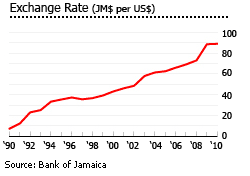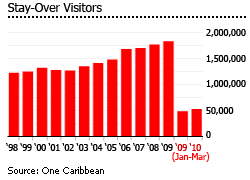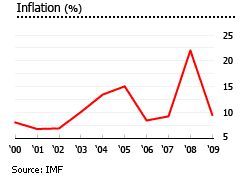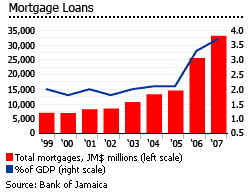Jamaican housing market slow to recover

Jamaica’s economy is showing signs of recovery, but its housing market has yet to reflect this. Property sales are more or less at a standstill, while the number of domestic rentals has soared. Jamaica’s real estate market has struggled for the last few years, thanks to weak economic growth, high inflation, and high crime rates. In 2009, property prices fell as foreign demand weakened and many overpriced properties underwent a price correction. Sales volumes dropped as well. “The Jamaican housing market has been flat or in decline in the upper end of the market for 2010 relative to 2009,” says Edwin Wint, President of the Realtors Association of Jamaica. “The lower middle income market segment is still active, but the rate of increase is diminishing.”
But hopes are high that the market will rebound in 2011. The government has taken measures to slow down inflation and lower the country’s massive debt-to-GDP ratio to sustainable levels. The launch of the Jamaica Debt Exchange Offer (JDX) in early 2010 has been seen as a positive step in the right direction, and the appreciation of the Jamaican dollar since it hit a low of J$89.73 in February 2010 has been slight but steady.
The country’s agricultural sector, transport and communications as well as manufacturing and industry are still in decline. The tourism sector, which comprises a sizable chunk of Jamaica’s economy, was badly hit by the global economic crisis, but a marginally more favorable crime rate as well as new marketing strategies being developed by the Jamaica Ministry of Tourism and its counterparts throughout the Caribbean region bodes well for the industry’s slow recovery.
Crime, violence, and the effect on the tourism sector
After a heartening upward trend during the first quarter of 2010, Jamaica’s tourism industry suffered yet another setback during the second quarter.

In May 2010, the U.S. State Department issued a travel alert for visitors to the country, responding to the growing wave of unrest in the capital of Kingston and surrounding areas after the Jamaican government issued an arrest warrant for the international drug lord and weapons trafficker Christopher “Dudus” Coke. While Coke was arrested one month later on June 22, the travel alert has been renewed because of sporadic bouts of violence following Coke’s arrest and extradition to the United States.
Earlier this year the Overseas Security Advisory Council released a Crime and Safety Report on Jamaica that indicated a rise in violent crimes in urban areas in 2009, ranging from burglaries and shootings to sexual assault and homicide. However, the Jamaica Observer recently reported a significant decrease in the number of the above crimes committed in 2010.
At any rate, visitors who come to the island are largely untouched by violent crime; since much of the criminiality occurs in Kingston, many of the resort areas such as Montego Bay and Negril have not been affected as much as experts feared. The major resorts also have strict security measures in place to protect their patrons. Tourist visits to “attractions” in Jamaica are guided by the resorts and these selected areas are tightly controlled by the police.
Security concerns have contributed to the dramatic downward spiral in the number of stopover visitors to the island, but this may be subject to change following the start of the summer holiday season. To shore up tourism in the region, Jamaican Minister of Tourism Edmund Bartlett is currently in talks with other leaders in the Caribbean Community and Common Market (CARICOM) to plan a new regional tourism strategy of "multi-destination marketing" with the aviation industry which will ensure greater flexibility and cooperation among the different Caribbean nations to encourage visitor travel to multiple destinations.
Positive economic prospects

Jamaica’s economy is fundamentally weak—the result of a series of troubles that hit the country in the past decades. Jamaica suffers from serious debt problems (with debt-to-GDP ratio at 135%), high inflation, excessive depreciation of the Jamaican dollar, high unemployment rates and very low economic growth.
The global economic meltdown aggravated the country’s situation. Together with the Bahamas, Jamaica was the only Caribbean country to fall into recession in 2008, with GDP shrinking by 1.2% and declining even further in 2009. The Planning Institute of Jamaica reports, however, that while real GDP fell even further by 1.4% in Q1 2010, reflecting the further weakening of the manufacturing, communications, and transport sectors of the economy, there was significant growth in agriculture, utilities, and tourism. Even though inflation rates rose 4.1%, the number of exports by the country rose by 6.9% while imports fell by 18.8%.
There may be some good news on the horizon. The government is pinning its hopes on the J$700 billion-Jamaica Debt Exchange (JDX), which invites Jamaican residents who hold certain domestic debt instruments issued on or before December 31, 2009 and maturing on or after February 16, 2010 to exchange them for new, longer-dated debt instruments.
The JDX has already produced results. The Jamaica Observer reports that according to the IMF, the treasury bill rate is projected to be 11% at the end of fiscal year 2010/2011 (it was earlier projected to be 13.1%) and expected to be even lower in the fiscal year 2011/2012 (9.8%, down from the earlier projection of 10.6%). The commercial property market is already feeling the positive effects, says Wint. “Pension funds and other corporate investors are opting to increase their property portfolio to hedge for better returns over time. The mortgage rates have been slow in trending down, but some lenders have been signaling this intent.”
The government also hopes that the JDX will also help raise GDP real growth and reduce the government’s debt service costs, which in the last 10 years has averaged 112% of total revenues. The government projects that for 2009-2010, the government’s debt service will be 103% of total revenues (J$325.5 million to J$316 million). Reduced debt service costs will lead to a lower fiscal deficit in the fiscal year of 2010-2011.
In March 2010, Moody’s upgraded Jamaica’s credit score on sovereign bonds to B3 – not largely positive, but at least it acknowledges a diminished risk of debt defaulting, and a change from January 2010, when the credit rating agency pronounced Jamaica in technical default. Standard and Poor’s also upgraded Jamaica to B-, up from SD (structural default).

The IMF, World Bank, the Inter-American Development Bank and the Caribbean Development Bank have also pledged a total of US$2.4 billion to support Jamaica’s economic recovery program.
The JDX has already produced results. The Jamaica Observer reports that according to the IMF, the treasury bill rate is projected to be 11% at the end of fiscal year 2010/2011 (it was earlier projected to be 13.1%) and expected to be even lower in the fiscal year 2011/2012 (9.8%, down from the earlier projection of 10.6%).
Interest rates have already fallen below their targets: the key 91-day rate is at 8.52%, and the 28-day yield averaged 8.98% as of June 23, 2010. The 30-day Bank of Jamaica Certificate of Deposit rate went from 9.5% to 9% (June 17).
Jamaica still has its work cut out, with inflation at 14% as of May 2010. However, the government believes it is on track to achieving an inflation decrease to 7.5%-9.5% this fiscal year.
Recovering currency
The Jamaican dollar (JMD) had sharply depreciated over the past two decades, despite government intervention. As of June 2010, the exchange rate stood at JMD86.63 to the US dollar. It has been on a slight upswing since it hit JMD 89.73 in February 2010, the lowest since the Jamaican dollar replaced the Jamaican pound in 1969.
Small mortgage market

The Jamaican mortgage market is very small. From 2.3% of GDP in 1999, the mortgage market grew to just 4.3% of GDP in 2007. This sluggish growth is because of two main reasons:
The real estate market in Jamaica is dependent on wealthy foreign and expat homebuyers, who usually pay in cash and in foreign currency.
Mortgages interest rates are relatively high and uncertain in Jamaica, driving foreigners to obtain financing in their home countries.
The maximum loan-to-value (LTV) ratio for foreigners is about 70% of the appraised value of the property, with a term period of 20 years.
Total mortgage loans were about J$33 billion (US$370.8 million) in 2007, 29.4% up from a year earlier. Building societies dominate the mortgage market with about 58.4% market share. The two government-owned companies, National Housing Trust and National Housing Development Corporation, account for 34.6% and 5.8% of the market, respectively. Credit unions and insurance companies hold the remaining 1.2% of the total mortgage loans.
The total number of outstanding mortgage loans was 12,284 in 2007, 16% up from a year earlier. However in the first three quarters of 2008, mortgages loans fell by 8.2% to 8,553 from the same period last year.
Improved rental market

While property sales have declined, the number of rentals have increased by as much as 40% in 2009 and Q1 2010 as property owners reduced rental rates to attract more tenants.
In 2008, the rent for four-bedroom houses rose by 6% from a year earlier. In early 2009, the demand for high-end rental properties slowed. As the number of foreign (U.S.) rentals declined, more property owners have turned their sights to the domestic market, offering large discounts to local renters and resulting in a market that owes its improvement more to volume and not to actual increase in revenue. Moreover, adds Wint, the increase in the number of renters does not reflect the general property market but is primarily centered on certain upper-end and luxury residential market areas.